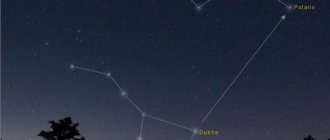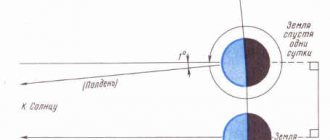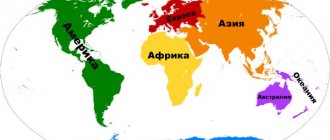Category: Walking in the Sky Published 01/26/2019 · Comments: 0 · Reading time: 5 min · Views: Post Views: 25,320
In truth, the starry sky is a rather chaotic picture. You need to have a very developed imagination to see, like the ancients, figures of people, animals and various objects in randomly scattered stars. But there are also truly stunning star drawings that catch your eye! One of these drawings is the famous Big Dipper , the main landmark in our sky. By the way, the Big Dipper is not a constellation, but only a part of the constellation Ursa Major. How can you find the entire Big Dipper in the sky?
The answer is simple: pushing off from the bucket!
But first you need to find the bucket itself.
What does Ursa Major look like, description and characteristics
Photo of Ursa Major in the night sky
Ursa Major is the third largest constellation. The cluster occupies more than 3% of the entire starry sky, and its area is 1279.66 sq. deg. It revolves around the North Star, thanks to which it is above the horizon at any time of the year and is clearly visible in the sky.
Ursa Major is made up of seven bright stars that together form the shape of a ladle with a handle. In Latin, the constellation is called Ursa Major and has the abbreviation UMa.
A large number of constellations border the cluster.
This is not surprising, given the impressive dimensions. The list of neighbors includes: Dragon, Giraffe, Veronica's Hair, Hounds and both Lions. Interesting fact : since in the fall the Big Dipper descends to the horizon, there was a legend among the Indians that this is how the animal prepares for hibernation.
On the territory of Russia, the constellation is clearly visible at any time of the year, but in April its stars shine much brighter than in other months. By the movements of the Big Dipper you can find out the month and approximate date. And in Ancient China, people were able to determine the time by the location of the Ladle handle.
How to find the Big Dipper in the sky?
Image of Ursa Major and Ursa Minor
Almost any constellation is quite difficult to find in the sky without special equipment. However, thanks to the clearly defined Bucket, determining the location of the Big Dipper is not difficult. It is enough for a person to find this asterism, and then the problem will be solved.
At the end of summer and beginning of autumn, the Bucket is located in the northern part of the starry sky. For better observation, it is recommended to wait until nightfall and leave the city so that the light of houses and lanterns does not interrupt the starlight.
Interesting fact : it is easy to determine north by the location of the Sun at noon. The star at this hour is on the opposite side, in the south.
In autumn, the asterism is located high in the sky at night and has a horizontal position. The brightness of the stars that make up it is enough for the human eye to immediately notice them, and the brain to connect them with straight lines into the desired object.
Since the Earth rotates around the Sun and its axis, the location of the constellations in the starry sky, when observed from one point, gradually changes. Because of this, from January to February, the Big Dipper gradually rotates in a circle: The bucket tilts with its handle down from a horizontal position. And the position of the cluster itself is gradually moving to the northeast.
In the spring, it is most difficult to find the Bucket in the starry sky. During this period, the asterism is finally turned upside down, which is why an ignorant person may never notice it.
Ursa Major is worst visible in northern Russia. There are often white nights in this area, due to which the stars are not visible. And when observing the constellation from the middle and southern stripes, you need to keep in mind that the Bucket at this viewing angle is positioned with the handle up.
Movement of the constellation across the sky
Finding the constellation Ursa Major and Ursa Minor in the sky is quite easy. It is best seen in March and April. On crisp spring nights, we may spot the Big Dipper directly overhead. The luminaries are high in the sky. However, after the first half of April, the cluster of celestial bodies moves to the west. During the summer months, the constellation slowly moves northwest. And at the end of August you can see the bucket very low in the north. There he will remain until winter. During the winter period, the Big Dipper will again rise above the horizon, starting anew its movement from north to northeast.
Ursa Major as imagined by ancient people
One of the options for depicting Ursa Major on the star map
Ursa Major is considered one of the oldest constellations, since almost all civilizations that have ever lived on Earth have a mention of it. The first records of the cluster are found in India, where people called it “Sapta Rishi” (seven sages). This name comes from the seven main stars that make up the Ladle. The latter was also noticed by the Chinese, who even determined the time by its location in the sky.
The Greeks, when compiling a description of the Big Dipper, came up with a beautiful legend. It is known that Zeus often paid attention to beautiful girls. Callisto, the daughter of the king of Arcadia, was no exception. The god's wife, Hera, learned about the intrigue and decided to take revenge. And so that the girl would not know the wrath of the goddess, Zeus turned her into a bear and sent her to live in heaven, where she was completely safe.
The Indians also saw a bear in this figure, but according to them, the beast consists of only four stars forming a trapezoid. And the handle of the Bucket is three hunters pursuing the animal: Aliot goes first and holds a bow in his hands, Mizar carries a cauldron, and the Benetnash detachment brings up the rear with an armful of brushwood to start a fire.
Stars of Ursa Major
The main stars of Ursa Major
Ursa Major consists of an impressive number of stars. However, in its asterism, the Bucket, there are only seven luminaries that make up a clear shape. Modern technologies allow astronomers to continuously observe them and obtain the necessary information. The Ursa Major asterism consists of:
- Dubhe - acts as alpha and is considered the second brightest star in the constellation. Careful studies have shown that Dukbe consists of two luminaries: the main sequence and an orange giant.
- Merak is a beta cluster. Although it is not considered the most visible in the starry sky, it shines 69 times brighter than the Sun.
- Fekda is a luminary located in the lower part of the Ladle, under the handle.
- Megrets is the faintest star of Ursa Major.
- Alioth is the brightest star in the cluster and is the most visible in the sky.
- Mizar is difficult to see because the star Alcor is located nearby, which is almost twice as bright.
- Alkaid is the most distant luminary from the general group, located at the end of the handle of the Ladle.
In addition to the seven from the asterism, the constellation includes approximately 125 stars. The human eye can only see a couple dozen of them. The most noticeable are the three luminaries located to the right of the Dubhe-Merak ligament. They form a triangle. In the lower right corner of the Bucket there is a similar figure consisting of the luminaries: lambda, mu and psi.
Fun fact : In some cultures, these two triangles represent the back and front legs of a bear.
Image of Polaris in relation to Ursa Major
Also, several key stars are located to the right of the Bucket, and in Russia only two luminaries are hidden behind the horizon. And since in the Russian Federation the constellation is always in the sky, local astronomers and people who navigate the starry sky can easily find the following objects using it:
- Polar Star;
- Cassiopeia;
- nearby is the constellation Leo;
- stars Capella and Arcturus;
- constellation Gemini;
- constellation Virgo.
Interesting: Why is a black hole black? Description, photo and video
If you know in which direction these objects are located relative to the Big Dipper, you can easily find them.
Stars in the Bucket Cluster
The constellation Ursa Major and Ursa Minor in the starry sky are rightfully considered the most famous and recognizable of the cluster of stars in the northern hemisphere. As we know from childhood, the stars of Ursa Major form a bucket in the sky - luminaries of a recognizable shape and with an established name. This cluster of nocturnal and celestial bodies rightfully ranks third in size. In the first positions are constellations such as Virgo and Hydra. There are 125 stars in Ursa Major. All of them can be distinguished with the naked eye. The bucket forms seven brightest stars. Each of them has its own name.
Let's turn our attention to the constellation Ursa Major. It is no longer possible to imagine the world of space without it. Among the stars in this cluster are:
- Dubhe means “bear”. This is the brightest star in Ursa Major.
- Merak is the second brightest star. It is translated as “lower back”.
- Fekda – translated means “thigh”.
- Megrets – translated as “beginning of the tail.”
- Aliot means “fat tail”.
- Mizar – translated as “loincloth”.
- Benetnash – literally translated as “leader of the mourners.”
This is only part of the stars that make up the famous cluster.
Diversity of Ursa Major objects
Owl Nebula
Most objects of the Big Dipper are visible only with professional equipment. With an amateur telescope, you can only see the “Owl Nebula,” designated M97. Next to it is the star Merak.
Galaxies
The sector of the starry sky where Ursa Major is located boasts the presence of one and a half thousand galaxies that are of particular interest to astronomers. And since the cluster is located in the Milky Way region, most of them can be seen with a professional telescope.
Galaxies M81 and M82
At a distance of 12 million light years from Earth, the Cigar, Bode and Pinwheel galaxies are located, designated M82, M81 and M101, respectively. Moreover, the first is considered one of the most beautiful objects in space, since its arms have a violet-blue glow, and the bright center is clearly defined and presented in the form of a blue sphere.
The spiral Pinwheel Galaxy has long, rounded tails surrounded by many bright objects. Astronomers compare them to fireworks because they resemble an exploding fireworks display.
Galaxy M108
Near the star Merak there is a galaxy M108. Its center is hidden from observation due to dust clouds. They also absorb its brightness, which when observed from Earth is approximately 12m.
Not far from the luminary Fekda you can see the Vacuum Cleaner galaxy, designated M109. It is considered one of the most difficult objects to observe, since the star often obscures its glow.
As astronomers observe the sector where the Polar Bear is located, they regularly find new galaxies with unique features. Convenient location in the sky allows you to see even the most distant objects.
The secret of the stars Mizar and Alcor
In the Ursa Major cluster there is a fascinating star pair - Mizar and Alcor. Why is she interesting? In ancient times, these two stars were used to check the acuity of human vision. Mizar is a medium-sized star in the bowl of Ursa Major. Next to it is the barely visible Alcor star. A person with good eyesight will see these two stars without any problems, and vice versa, a person with poor eyesight will not be able to distinguish between two luminaries in the sky. They will seem to him like one bright point in the sky. But these two stars are fraught with a couple more amazing mysteries.
The naked eye does not see the features inherent in them. If you point a telescope at Mizar, you can see two stars instead of one. They were conventionally designated Mizar A and Mizar B. But that’s not all. Spectral analysis revealed that Mizar A consists of two stars, and Mizar B - of three. Unfortunately, these night luminaries are so far from the earth that no optical devices can reach them so that the secret can be fully revealed.
Ursa Major: dipper in autumn
Detailed image of the Big Dipper
Since all space objects are in continuous motion, at different times of the year the Big Dipper is located in a certain area of the starry sky. In autumn, most of the luminaries are hidden from human eyes. However, the constellation asterism is an exception. Its seven main stars, although not as bright between September and November, can be seen with the naked eye.
In autumn, Ursa Major is located in the north, below the North Star. The bucket is turned with its handle towards the west. To the east you can see the constellation Pleiades, next to which Aldebaran glows. In the northeast there are the main luminaries that make up Gemini.
But not all clusters can be seen in the fall. Virgo and Leo on the territory of Russia go beyond the horizon, and because of the Big Dipper, in the western region, the Eagle is barely visible.
The brightest constellations in the autumn sky are:
- Ursa Major and Ursa Minor;
- Swan;
- Calf;
- Twins.
These clusters can be seen at night without special equipment. To observe other objects, astronomers use professional telescopes that are powerful enough to bring the stars and galaxies of interest close enough. For example, the Hubble telescope can observe more than a thousand galaxies located in the Ursa Major star sector. Thanks to this, scientists do not need to take seasonal breaks and stop working.
Constellations of the northern hemisphere
Just as the map of the Earth is divided into the eastern and western hemispheres, the map of the night sky can also be divided into two hemispheres - the northern and southern. And also the equatorial part. We are located in the Northern part, so we will consider it specifically.
The constellations of the northern hemisphere are those constellations that can be seen by residents on the northern side of the equator. And residents of the southern hemisphere will not be able to see them, because the Earth, on the scale of the universe, occupies a static position in relation to the other stars.
Some constellations of the northern hemisphere are always visible. These are those that are located close to the polar star (circumpolar constellations). And the polar star is a landmark pointing to the North Pole. These are Ursa Major and Ursa Minor, Andromeda, Cassiopeia, Dragon, Cepheus, Lynx, Hounds.
Other constellations either appear or go beyond the horizon at different times of the year. In summer, Perseus, the Northern Crown, Lyre, Coma Berenice, Bootes, and Hercules are clearly visible. In winter, you can see Orion, because bright Betelgeuse is one of the first to appear on the celestial canvas. However, it is also worth considering the breadth of residence. After all, the northern half of the Earth is also very large. And what a person living in the north and in the south sees may be different.
This concludes the theoretical part. Now we begin the practical part of our walk through the night sky.
Myths about the origin of Ursa Major
Arkad and Callisto
There are several legends about the formation of the constellation. The most interesting and popular is Greek. It was already mentioned above about the girl Callisto, the daughter of the king of Arcadia, to whom Zeus drew the attention.
But there is another version of the myth. In her youth, Artemis often went hunting in the forest, trying to find various game. She took with her young girls of extraordinary beauty as assistants. Among them, Callisto had the most striking appearance.
Her beauty attracted Zeus. And in order to gain the favor of Callisto, the god pretended to be Artemis. After some time, the girl had a son, Arkad. Zeus's wife, Hera, found out about her husband's act and, out of anger, turned Callisto into a bear with an unsightly appearance.
Arkad grew up and became a hunter. Setting out once again in search of prey, the young man met his mother in the guise of a bear. He did not recognize her and was about to shoot with a bow, but Zeus intervened and turned both of them into constellations in the sky. So Callisto became Ursa Major, and Arkad became Ursa Minor.
Since then, they have always been together in the starry sky, and due to the peculiarities of their location, it seems that both clusters seem to be looking out for each other. And if a person has found one constellation in the sky, then he can easily find the second one.
Interesting fact : since the stars Benetnash and Dukhbe move in the opposite direction than the other stars, the Bucket gradually changes shape over the course of the year.
When is the best time to see Ursa Major?
Artificial highlighting of the stars of the Big Dipper
To see the Big Dipper on the territory of the Russian Federation, you need to travel outside the city so that the light of the lights does not cover celestial objects. The most favorable time to observe the cluster is between March and April.
Interesting fact : in the first weeks of April, Moscow residents can observe the Big Dipper at its zenith.
During these months, Ursa Major rises to its zenith, and every day, at approximately 23:00, the stars reach their peak brightness. Looking up, a person will immediately be able to find the Ladle. And if he has at least amateur binoculars at his disposal, he will be able to see not only the seven main stars, but also nearby objects.
The worst time to see the Big Dipper is autumn. At this time, the asterism loses its brightness, and to detect neighboring stars related to the constellation, you cannot do without a telescope.
Orientation using the Ursa Major Bucket
Landmark for the Big Dipper and the Polar Star
Thanks to its good brightness, the Big Dipper has served as a reliable landmark for people since ancient times. Depending on the time of year, experienced trackers using the Bucket could determine the location of the cardinal points and go to the right direction.
Most importantly, Ursa Major helps to find the North Star in the sky. If you mentally draw a straight line from the luminary to the ground, you can accurately determine the north using this perpendicular.
Interesting fact : on the territory of Ancient Russia, the constellation was called the Horse because of its characteristic shape. The polar star was considered a peg to which the animal was tied.
Once you know the location of the north, you can immediately understand where the other directions are: south is behind, west is on the left, east is on the right. The stars Arcturus and Spica, located in the south, help to navigate in space. In the Middle Ages, sailors used them to accurately determine the correct course while in a boat in the middle of the night sky.
The advantage of the Big Dipper as a landmark is that it covers a large area in space. Even if observations are made in cloudy weather, there is a high probability that at least some part of the Bucket will be visible in the sky. This will already be enough to determine the location of the north.
Changing the position of stars depending on the time of day
Focus on how the location of the constellations Ursa Major and Ursa Minor changes throughout the day. For example, in February, at night, we see a bucket with its handle down, located in the northeast, and the next morning the constellation will move to the northwest. The handle will turn upward.
Interestingly, the five stars inside the bucket form one group and move separately from the other two stars. Dubhe and Benetnash slowly move away in the opposite direction from the other five luminaries. It follows that in the near future the bucket will take on a completely different look. But we will not be destined to see this, since a significant change will become noticeable in about a hundred thousand years.











